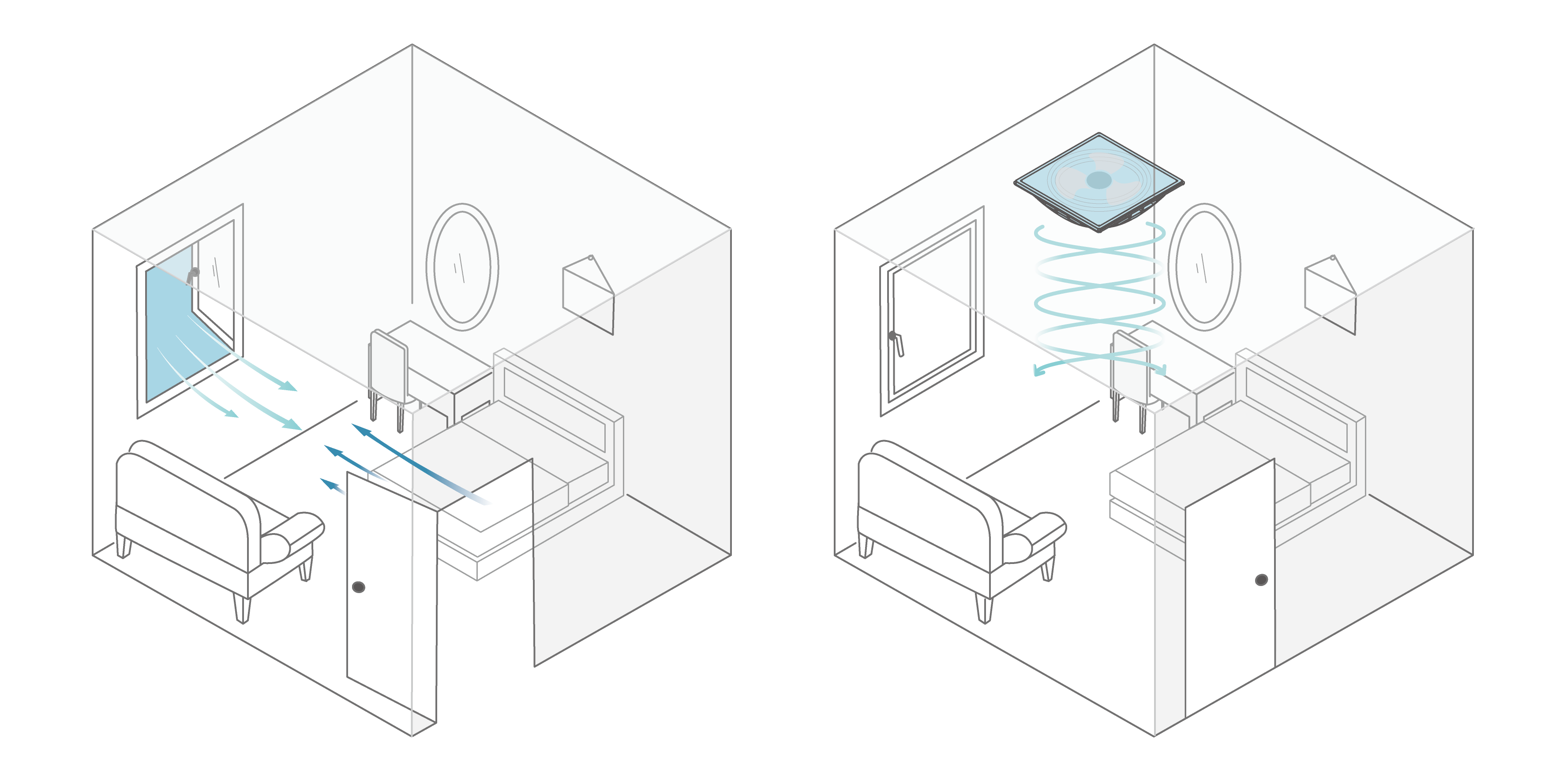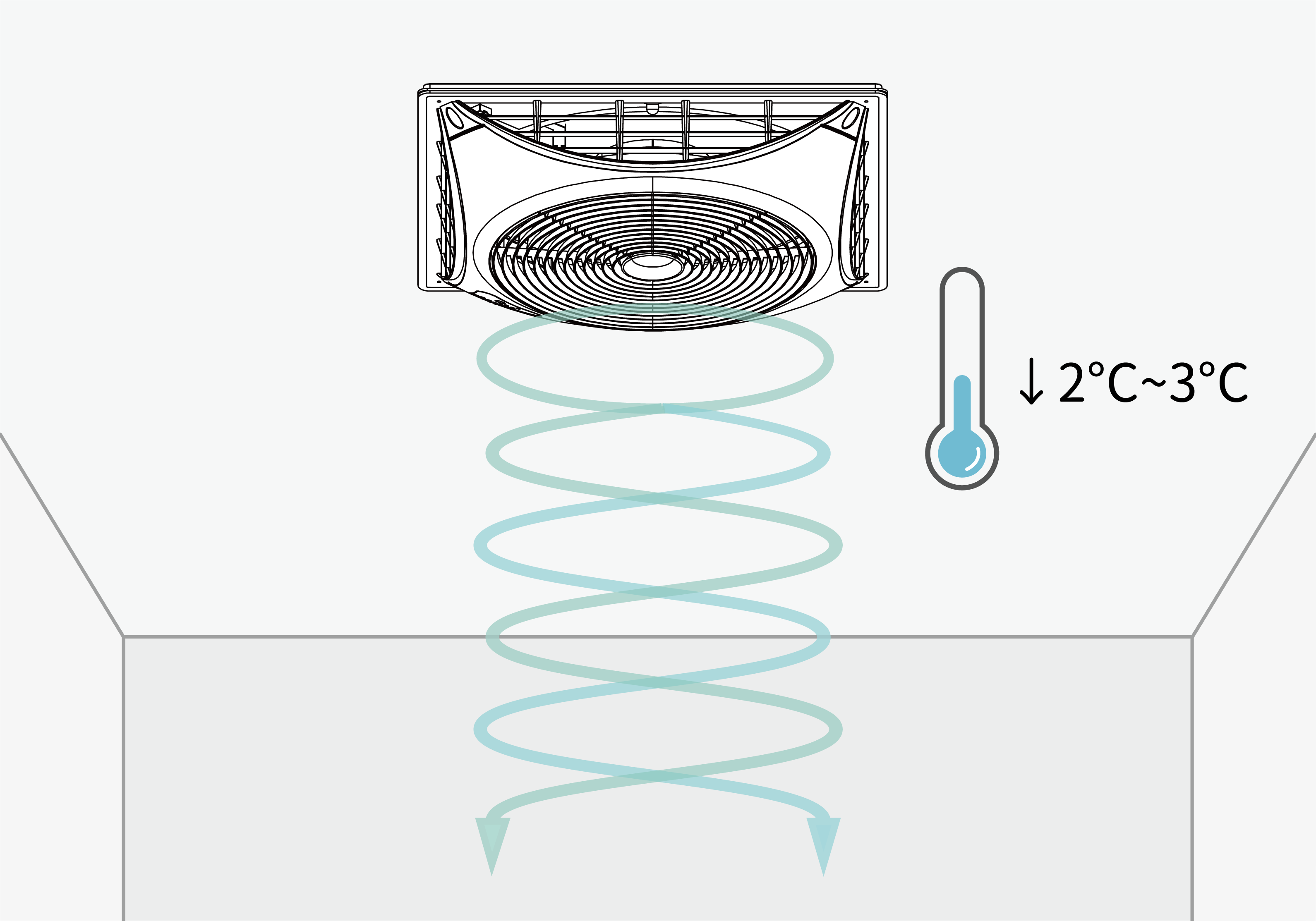Why do you need a circulation fan in the office/room/conference room?
- Balance the indoor temperature.
- Adjust the cold air from the air conditioner.
- The blades are low-angled to decrease the power consumption.
- It is a trendy design for modern indoor architecture while still maintaining high functionality.
- Keep the floor dry.
- Efficiently cool the indoor-area.
What types of False Ceiling Fans do we need?
Recessed fans (exhaust type)
- Perfect for large offices, retail showrooms, kitchens, and bathrooms with false ceilings.
Ceiling fans
- Ceiling fans have an extensive range of style and designs. It is important to decide on the installation location for optimum cooling.
What are the health risks from indoor pollution?
- Asbestos can cause lung cancer.
- Biological pollutants can cause allergies, viral or bacterial infections.
- Formaldehyde can affect the respiratory system and cause cancer.
- Carbon Monoxide and Carbon Dioxide (CO, CO2) can cause hypoxia which can cause headaches.
- Dust can harm the respiratory system.
- Volatile organic compounds can affect liver and kidney function.
What causes indoor pollution?
(1) Suspended particles(2) Second-hand smoke
(3) Organic substances - Cleaning agents, cosmetics, adhesives, natural gas, paint, pesticides,cigarettes, and various personal care cleaning products such as perfumes, hair sculptures, etc.
(4) Formaldehyde-wood plywood, wood furniture, partitions, mineral fiber ceilings, adhesives,detergents and other materials.
What types of False Ceilings should I choose?
- Gypsum Plasterboard False Ceiling System: Gypsum ceilings are lightweight, fire resistant, and thermally insulated. Since it is a monolithic suspended platform, you will see that the finished product will have a smooth and beautiful appearance. This gypsum board can accommodate or be molded into many designs, including curves, steps, zigzag patterns etc. It is designed for easy cleaning.
- Grid Ceiling System: This is created by using a metal grid system that is hung through a series of metal wires to create a suspended ceiling. It is useful for its excellent sound reduction and absorption properties. It could be used with a wide variety of materials and textures.
- Gyptone Ceilings: They are extremely easy to maintain and have a very long use-life. The material has an outstanding sound absorption range (0.8 to 0.85).
How do you circulate fresh air in a room?
(1) Natural ventilation-open doors or windows to maintain ventilation.(2) Mechanical ventilation-electric fans, air conditioners, window exhaust fans,full heat exchangers and other equipment.

Where should fans be placed in a room?
According to the size of the space to determine the place to be placed.Do fans help circulate air conditioning?
Global warming affects our lives, JLA’s product #JD-2000 air circulation fan helps to drop temperature quickly and accelerate circulation.
What is the most reliable ceiling fan?
Pass the national BSMI certification and comply with safety regulations. Our company has more than 38 years of experience, durable products and low maintenance rate.
Should you run a fan in an empty room?
If the fan is kept on, the indoor air circulation can be maintained.
Which type of false ceiling is best?
The functional requirements are based on the environment of the installation site, but we can choose the design to facilitate disassembly and assembly to facilitate long-term use, cleaning and maintenance.
Are 3 or 4 blade ceiling fans better?
In the case of a fan of the same size, the area of four blades is smaller than 3 blades, and the blowing wind is also softer.
What are some long term and short term effects of indoor air pollution on human health?
Long term: Changes in climate and water cycle affect agriculture, reservoirs and biodiversity.
Short term: Air pollution directly harms the lungs and tracheal function of the human body.
What are the effects of pollution on human health?
Air pollution directly harms the lungs and tracheal function of the human body.
What causes indoor pollution?
(1)Indoor combustion sources: The most common indoor combustion behaviors are cooking and heating. The pollutants emitted by combustion are carbon monoxide, carbon dioxide and PM2.5.
(2)Building materials: Plywood and partitions are commonly used in decoration because of the use of formaldehyde resin-containing bonding agents.
(3)Paints and coatings: When using paints and coatings, they often need to be diluted with organic solvents, so volatile organic pollutants are released during the process.
(4)Cleaning products, personal care products: cleaning products cause the emission of volatile organic pollutants.
(5)Office business machine: Ozone and suspended particulates are generated when used.
(6)Biological pollutants: When the indoor environment is humid and dirty, bacteria may breed.
(7)Human activities: Respiration produces carbon dioxide, human body and pet dander, hair, dust caused by indoor activities, and pollen produced by indoor plants are all sources of pollution. The direct second-hand smoke emitted by smokers and the indirect environmental second-hand smoke.
